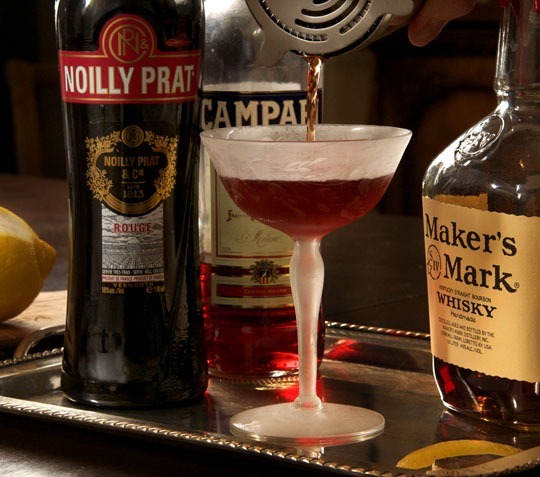Michael Ruhlman's Blog, page 44
March 8, 2013
Friday Cocktail Hour: The Donna Paloma
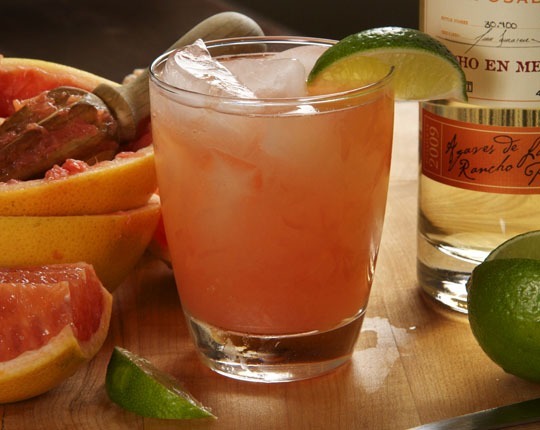
A freshly made Paloma. Photo by Donna Turner Ruhlman.
I’ve written before in the depths of winter that now is grapefruit season and grapefruits were my first realization that food was in fact seasonal. It was 1989 and I’d grown up in a country where I could buy pretty much anything I knew about all year long and this was the natural way of the world. I’d fallen in love with Donna, who was a photographer for the Palm Beach Daily News, but I kept long-held plans and left her to travel Africa and Asia, only to find myself 10 weeks later on the porch of an American expatriate living in Ouagadougou. A monkey jumped onto my lap, and I thought What the hell am I doing in Ouagadougou when I’m in love with this beautiful photographer in southern Florida?
I couldn’t answer the question. I caught a train to Abidjan and from the Côte d’Ivoire a plane home. I packed my little Mazda 626 with everything I owned and drove from Cleveland to Florida, with dinner and a few hours’ sleep at the home of my mentor in Durham, NC.
A few months later, mid-February, there was grapefruit everywhere. I was astonished. Look at all these trees that used to have just leaves, in front lawns and backyards, trees heavy with grapefruit. AMAZING grapefruit. They grew in abundance behind a little cottage I was able to rent on that opulent plump island. I lived on the stuff.
So I wanted to honor the grapefruit in its season for this Friday Cocktail Hour, and I do so happily by reprising a summertime drink I’m so fond of, the Paloma, which also happens to be my favorite cocktail photograph by the woman who decided to marry me a year and a half after the monkey jumped onto my lap.
Cure the wintertime blues with a blast of vitamin C and some reposado tequila (any good tequila will do), 2 to 1 juice to booze, and a squeeze of lime to finish. That’s it!
The Donna Paloma
2 ounces añejo or reposado tequila
4 ounces freshly squeezed Florida grapefruit juice
1 fat lime wedge
Combine the hooch and the juice in glass, fill with ice, garnish with lime. Put on some shades and listen to Ramsey Lewis’s “Sun Goddess.”
Check out these other links:
My post on making margaritas.
Be a member of the Tequila Interchange Project.
Rick Bayless’s Frontera Grill in Chicago has some pretty stellar margaritas; here are some of his cocktail recipes.
© 2013 Michael Ruhlman. Photo © 2013 Donna Turner Ruhlman. All rights reserved.
March 6, 2013
Hungry for Spring (and Request to Readers)

Longing for spring during these gray days. Photo by Donna Turner Ruhlman.
Cleveland weather today is mild, uncommon for this time. We’re not in the throes of the current blizzard, but I’m still sick of this cold and gray. The kids are weary of school. I’m morose in my work, dulled by routine, longing for spring’s renewal. These carrots Donna shot long ago jumped out at me when I was going through some of her work and intensified the longing.
I’m in the final stages of finishing a draft of a new book about cooking (notice I avoid the term “cookbook”), the inevitable headache stage where I just need to get it done in order to leave it alone so that I can return to it and see it clearly.
As spring does approach and I long for maple leaves and vegetables, flowers, soft grass and humid air, I’m planning renewals of my own.
It’s time for a redesign of this site.
And I need to know what you—faithful reader and newcomer alike—find valuable here, what you like, what you’d like to see more of—Donna’s work? Opinion pieces? Recipes? Videos? Technique? What don’t you like?
And I’d love to know what kind of screen you are reading this on (I’ll bet it’s not on a phone—not that this site makes it easy for you to comment one way or another). One of the reasons for a redesign is the changing nature of media and the need to create a site that is pleasing no matter what you’re viewing it on, called a responsive site or responsive design.
But it’s also to keep things growing. Spring can’t come soon enough to Cleveland!
Check out these other links:
My post on French Onion Soup.
Follow me on Facebook and on Twitter.
Don’t forget to check out the Dalton-Ruhlman store or to see my shop on OpenSky.
© 2013 Michael Ruhlman. Photo © 2013 Donna Turner Ruhlman. All rights reserved.
March 4, 2013
In Love with French Onion Soup

Onion soup, with croutons and melted cheese/Photos by Donna Turner Ruhlman
Donna wanted to change the banner photo on my Facebook page and it got so many likes and comments that I knew it clearly struck a wintery warmth chord in dreary March. I’ve posted this before and here it is again from, Ruhlman’s Twenty, which looks at 20 key concepts that underlie all of cooking. This key concept is water. This onion soup requires nothing but onions and water for the soup part.
Plan ahead when making the soup because the onions take a long time to cook down, from a few hours to as many as five if you keep the heat very low, though you need to pay attention only at the beginning and the end. Before the onions caramelize, they’ll release copious amounts of water (be sure to taste this liquid!), which must cook off first. You can simmer the onions hard if you want to reduce the cooking time; be sure to tend the pot and stir often, or the onions can stick and burn. You can also caramelize the onions a day or two in advance, and refrigerate them for a quick delicious soup during the week, or even freeze the onions for up to a month. If you do this, the soup can be finished in the time it takes to heat the water and melt the cheese on top.
Traditional French Onion Soup
1 tablespoon butter
7 or 8 Spanish onions (7 to 8 pounds/3.2 to 3.6 kilograms), thinly sliced
Kosher salt
Freshly ground black pepper
6 to 12 slices of baguette or any country-style bread (it’s best if they cover the width of your serving bowls)
1/3 cup/75 milliliters sherry
Red or white wine vinegar (optional)
Red wine (optional)
1/2 to 3/4 pound/225 to 340 grams Gruyère or Emmanthaler cheese, grated
Use a large pot, with a capacity of about 7 1/2 quarts/7.1 liters, that will hold all the onions. An enameled cast-iron pot will provide the best surface. Place the pot over medium and melt the butter. Add the onions, sprinkle with 2 teaspoons salt, cover, and cook until the onions have heated through and started to steam. Uncover, reduce the heat to low, and cook, stirring occasionally (you should be able to leave the onions alone for an hour at a stretch once they’ve released their water). Season with several grinds of pepper.
Preheat the oven to 200°F/95°C. Place the bread slices in the oven and let them dry completely (you can leave the slices in the oven indefinitely, as the heat is not high enough to burn them).
When the onions have completely cooked down, the water has cooked off, and the onions have turned amber—this will take several hours—add 6 cups/1.4 liters of water. Raise the heat to high and bring the soup to a simmer, then reduce the heat to low. Add the sherry. Taste and season with salt and pepper as needed. If the soup is too sweet, add some vinegar. If you would like a little more depth, add a splash of red wine. I like the onion-to-liquid ratio with 6 cups of water. But if you’d prefer a slightly more delicate soup, add 1 cup/240 milliliters water.
Preheat the broiler/grill. Portion the soup into bowls, float the bread on top, cover with the cheese, and broil/grill until the cheese is melted and nicely browned. Serve immediately.
Serves 4 to 6
If you liked this post on French onion soup, check out these other links:
My post on making flaky biscuits.
Gruyère is an AOC cheese that comes only from Switzerland. Learn about Gruyère’s long history.
Stephanie’s guest post on Käsespätzle.
You can serve French onion soup in crocks, coffee mugs, or even plain ramekins.
© 2013 Michael Ruhlman. Photo © 2013 Donna Turner Ruhlman. All rights reserved.
March 1, 2013
Friday Cocktail Hour: The Rye Old-Fashioned
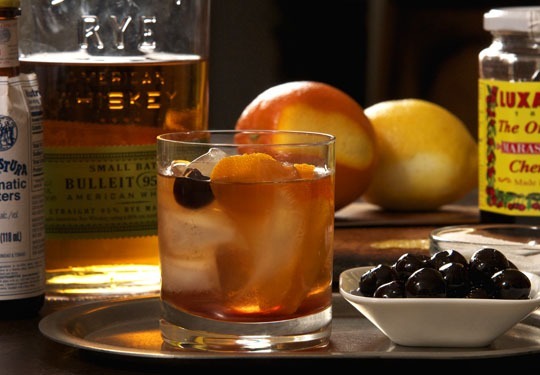
The Rye Old-Fashioned. Photo by Donna Turner Ruhlman.
My inclination is to simplify. And with this, one of the oldest and sturdiest of cocktails, the old fashioned, should be just that, as Brad Parsons notes in his excellent book Bitters, and in my original post on it. Sugar muddled with bitters, ice, American whiskey, and a twist. Brad laments that it’s too often gussied up and over-muddled with orange and overly adorned. Brad also notes a nostalgia for the gritty undissolved sugar, but nevertheless recommends simple syrup in his. I am like-minded on all counts.
Except. I splurged on these awesome cherries, “original” maraschinos. Also I really wanted to feature rye whiskey, here Bulleit rye, a whiskey on the upswing in America. And this great, great cocktail, the old fashioned, is perfectly suited to it. I’m doing what Brad suggests, only I’m adding a twist of orange because orange is a great seasoning, and the sweetness of the cherry with the dryness of the rye is fun. This is one of those perfect cocktails, like the Manhattan, that balances sweetness, with bitter, with citrus and, no measuring this time for god’s sakes, add ice and fill the glass with whiskey. Enjoy the gritty sugar finale. Preferably mix two, to share with with a dear old friend by a fire on a cold Friday eve.

Making a Rye Old-Fashioned
Rye Old-Fashioned
5 grams bitters (about)
1/2 teaspoon sugar (about)
Squeeze of orange, optional
Bulleit Rye, as needed
Lemon twist
One good cherry
In an old-fashioned glass muddle the bitters, sugar, and a squeeze of orange, if using. Get the sugar dissolved (or use 2 teaspoons simple syrup).
Fill the glass with ice, fill the glass with rye, garnish with a lemon twist and a good cherry.
If you liked this post, you might be interested in these links:
My cocktail post on the making of a Brandy Blazer.
The NYT’s fall 2012 preview of Eleven Madison Park, where they make one of the best Manhattans.
Learn how to make your own maraschino cherries.
Is rye whiskey back in fashion in the United States?
© 2013 Michael Ruhlman. Photo © 2013 Donna Turner Ruhlman. All rights reserved.
February 28, 2013
Tasting Menu: A Reading
This 12-minute reading is from The Soul of a Chef, on my first experience with a tasting menu. Though I had special consideration at the meal—I was not a paying customer—it is an honest and emotional description of what remains the most important restaurant meal of my life. I thought it apropos, following my previous post addressing recent criticisms in the media of today’s tasting menus. It’s not a polished video—I simply set up a tripod in my kitchen before dinner and read—so please forgive my lack of video production skills!
[For more information on what led up to my unlikely passage from unknown Cleveland-based writer to dinner at The French Laundry and what was to follow, read The Main Dish, a 35-page memoir of becoming an accidental food writer. It was published as a Kindle Single, $1.99, and is available on all devices (iPads, etc.); just download the free Kindle app.]
If you liked this post, you might be interested in these links:
My first run-in with Tony Bourdain happened to be in print when he reviewed The Soul of a Chef for The New York Times Book Review.
My book The Making of a Chef had not been published at the time of the meal in question, making my presence there all the more unlikely.
One of my assistant Emilia’s favorite tasting menus was had in Switzerland at Chef Phillipe Rochat’s Hotel de Ville.
Video: Next versus elBulli: Preparing for the elBulli tasting at Next restaurant in Chicago.
Not only Copenhagen’s top restaurant but, some say, the world’s: Noma.
© 2013 Michael Ruhlman. Photo © 2013 Donna Turner Ruhlman. All rights reserved.
February 26, 2013
Are Tasting Menus the Way Toward “Art”?
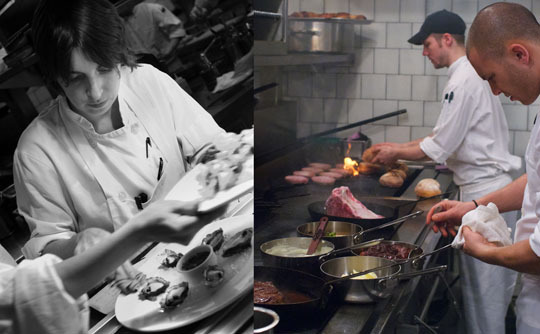
Cooks, Chefs, or Artists? Photos (at NYC’s Breslin) by Donna Turner Ruhlman.
“I always say this to the young chefs and mean it: The customer is excited, he says you are an artist, but we are not, just craftspeople with a little talent. If the chef is an artist, he doesn’t succeed. Why? Because he is inspired today but not tomorrow. We cannot do that.” —Andre Soltner (quoted in Forbes, May 2012)
Back in in the fall of 2008, nearly five years ago, I moderated a discussion between Tony Bourdain and Marco Pierre White (insofar as those two former chefs can be moderated at all). MPW railed against the multi-course tasting menu, and Bourdain reiterated it, while Grant Achatz, feeling personally attacked, fumed in the audience.
As I pointed out in a post addressing the event, The End of the Multi-Course Tasting? (scroll down past Tony’s curious remarks), I found it ironic that MPW was criticizing the very form of dining that had earned him his fame—high-end, highly egotistical food. I also thought it a little un-self-aware that these two celebrities criticize tasting menus given the fact that both he and Bourdain get clobbered with food by chefs eager to impress their culinary heroes, when all they really want is a good burger.
Now it seems that the issue is back with an attack on tasting menus by Corby Kummer in February’s Vanity Fair (it’s been out for a month) and Pete Wells’s more balanced article in the NYTimes last fall.
It should come as no surprise that I’d take issue with the Kummer story as he maligns a friend with whom I’ve worked since 1997, Thomas Keller, recalling not only the meal that made The French Laundry the number one restaurant in the United States, but a subsequent meal a few months later that “felt like a form of torture.”
I was actually there that night, and in the kitchen when Kummer stood at the chef’s station interviewing Keller and typing away on his laptop as Keller patiently responded to questions, and I had spoken with Kummer at length about what I was learning. I happened to have had a really good meal that night myself—I was there working on The French Laundry Cookbook—and don’t recall Kummer’s writing about the torture he experienced then. Now he’s railing against chefs’ power grab and taking the diner hostage—MPW was famous for throwing customers out back in the 90s—from a seat that is as rarefied as those held by MPW and Bourdain.
I guess what bothers me most about Kummer’s article is not what he says but rather the tone of hysteria that infuses the essay, the vehemence of his emotions about restaurant dining when, really, there are a lot more interesting issues, if not pressing ones, to report on. Wells has been charged with the task of being the consumer’s guide for the country’s paper of record, a serious responsibility. Kummer, in what is a kind of reported editorial rant, criticizes as from a throne, seeming to enjoy the sound of his own voice rather than offering useful opinion.
I get hysterical over a lot of things, but the tasting menu isn’t one of them. If I don’t want to eat that way, I don’t go to the restaurant. Wells’s and Kummer’s articles do make clear how difficult a tasting menu is to do, judging from the displeasure these professional writers about food experienced. It’s not simply about serving a lot of courses, it’s about balance. Yes, chefs are competitive, they want to impress, they want to stay fresh, avoid becoming bored, and in their zeal can certainly go overboard. But ultimately, a restaurant is a business, not an art museum, and the marketplace will decide whether a chef’s tasting menu succeeds or not.
The last three tasting menus I had (at Momofuku, Le Bernardin, and Next, the Japanese menu orchestrated by chef Dave Beran) were exemplary—exciting to eat throughout, each completely original, not overly long, and leaving us happily sated and not uncomfortably full.
I do think it’s a danger when a chef considers himself or herself an artist—much of our culture seems to take this for granted, and Kummer concludes his tirade with what he calls hopeful food-and-cooking-is-craft-not-art quotes from two other Frenchmen closer to Soltner’s era. Chefs who consider themselves artists are indeed setting themselves up for failure, as Soltner cautioned any cook who would listen. Only once they have become a superlative craftsman (Grant Achatz comes to mind, raising the dining experience to a kind of performance art) should they even attempt to raise food to the level of art. Thomas Keller, at his cooking zenith, always, and proudly, called himself a craftsman and would do so today, though he’s Chef-CEO, not Chef de Cuisine. But I would ask even those who self-consciously consider themselves artists, what is the purpose of turning food into art?
What is the purpose of art?
As Joseph Conrad wrote, the purpose of art is to make us see. And rare is the chef who transforms the way we see the world.
If you liked this post, then check out these other posts:
Chefs weigh in on the issue at eater.com.
My post on Donna’s lunch at Thomas Keller’s Per Se
Looking for other top-notch places to dine? Look at the Michelin Guide.
Next Restaurant in Chicago is always serving up a new tasting menu.
The New York Times Dining section is a must read.
© 2013 Michael Ruhlman. Photo © 2013 Donna Turner Ruhlman. All rights reserved.
February 22, 2013
Friday Cocktail Hour: The Boulevardier
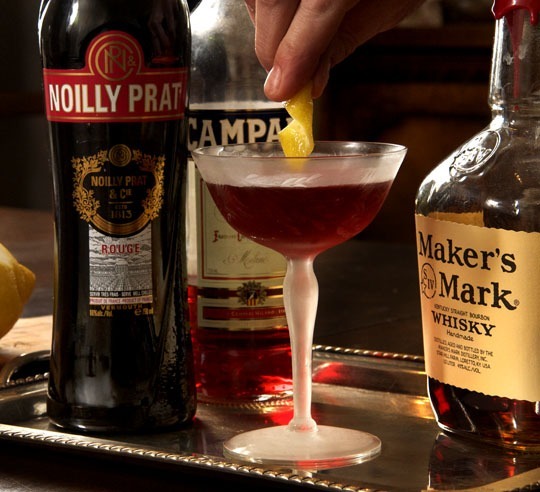
The Boulevardier. Photos by Donna Turner Ruhlman.
Were it not for the Internet, my guess is that only the most devoted barfly would know about the Boulevardier. It’s not in any of my cocktail books, not the standard-bearing The Standard Bartender’s Guide, my Madmen-era dad’s paperback. I only heard about it from a reader of this blog (with links below). And an email this week pushed me into a tasting, happily!
I love how various flavoring components (bitters, vermouths) become different cocktails when you change the spirit. How the Manhattan becomes a Rob Roy when you change the bourbon to scotch (as opposed to a lame-sounding “Scotch Manhattan”), or how a Martini becomes a … um, never mind about that #lostcause (Paulius, can we hope for Darwinian selection here?). I love the elasticity of a solid cocktail, how the addition of apple brandy turns a Clover Club into a Pink Lady.
Here, one of my favorite cocktails, the Negroni, becomes a Boulevardier when bourbon replaces the gin. A couple of recent essays (Tmagblog, Imbibe) have wondered why this cocktail isn’t on more menus and I agree. Interestingly, it was apparently invented 20 years before the Negroni in Paris by an American ex-pat socialite who ran a literary magazine, Boulevardier. I do like the 1:1:1 Negroni ratio, but I agree with the others that the Boulevardier is a richer, more satisfying cocktail using more bourbon, here 1.5 parts, with 1 part each vermouth and Campari.
It’s a strong cocktail, so this is one I’d happily recommend on the rocks as well as straight up. Danny Guess, mixologist at Fly Bar and Restaurant in Tampa, co-author of the iBook 25 Classic Cocktails, and a consultant on these cocktail posts, concurs.
It’s a splendid cocktail on a winter’s evening, when the work week is done, a stew simmers on the stove, and fire crackles on the hearth—complex, strong, smoky, and bittersweet.
The Boulevardier
45 grams bourbon (1.5 ounces)
30 grams Campari (1 ounce)
30 grams sweet vermouth (1 ounce)
lemon twist
Combine the ingredients in a pint glass filled with ice and strain into a cocktail glass or a rocks glass with ice, to preference.
Garnish with a twist of lemon zest.
Put your feet near a fire. Raise the glass to your companion if you’re with one. Otherwise do nothing, say nothing, as you enjoy your first sips of this fine elixir.
If you liked this post, check out these other links:
My cocktail posts on the Classic Manhattan, Mint Julep, and the Southside.
Maker’s Mark, a good all-purpose bourbon for a mixed drink, recently reversed a plan to lower its alcohol content following social media outrage (good business decision or did the company cower before blog bullies?).
What makes a bourbon bourbon?
Saveur covers the history of Campari and what makes it bitter.
© 2013 Michael Ruhlman. Photo © 2013 Donna Turner-Ruhlman. All rights reserved.
February 20, 2013
The Key to Flaky Biscuits
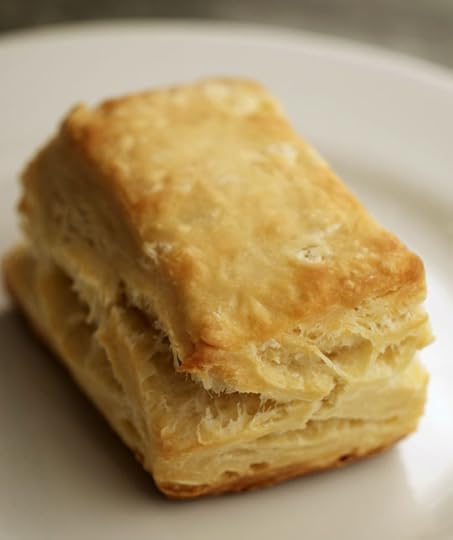
Nothing beats an oven fresh biscuit. Photo by Donna Turner Ruhlman
Ages ago a reader requested a biscuit post and now, in something of a dreary February brian hibernation, I thought would be the perfect time. Donna shot this biscuit while I was writing Ratio and what I love about it is not the ratio itself (3 parts flour : 1 part fat : 2 parts liquid) but rather how the rolling technique results in layered flakiness.
It’s kind of a cross between a pie crust and puff pastry. A pie crust is flaky because random knots of butter separate layers of dough and puff when baked. With puff pastry, one sets out to create precise layers of dough and butter, hundreds of them, by successively folding and rolling out a single block of butter encased in dough (called turns) for a uniform puff dough. Here, we make a looser pie crust (compare the 3-2-1 pie dough ratio), purposefully allowing chunks of butter to spread out in the dough then give the dough several “turns” to create multiple, though far from uniform, layers that puff when you bake them.
These buttery wonders are great for breakfasts and dinners, the dough made a day in advance if necessary, the biscuits baked and frozen for a week or more. For an amazing winter weekend breakfast, make a bechamel (cook butter and flour, add milk, heat till thick) then add sausage and onion to this and pour it over the biscuit for a classic biscuits and gravy breakfast.
Biscuits
9 ounces flour (a scant two cups)
2 teaspoons baking powder
1 teaspoon salt
3 ounces chilled butter, diced
6 ounces milk
Set a mixing bowl on a scale and pour out the flour. Add the baking powder (pressed through a strainer if it’s pebbly) and salt. Weigh out the butter. Rub and pinch the butter into the flour so that the butter is well distributed and in fragments and small chunks, the largest of which are not bigger than peas. Pour in 6 ounces of milk and combine just until a dough is formed (you will see distinct whole chunks of butter in the dough). Form into a 4-inch by 6-inch rectangle, wrap in plastic and refrigerate for at least an hour.
Unwrap the dough and dust it with flour. Roll the dough out to about three times it’s size on a floured counter, board or plastic wrap, maintaining the rectangular shape. Fold it into thirds and roll it out again (it will be more resistant and springy now). Fold it in thirds again, press it down firmly, wrap it in the plastic wrap and refrigerate it for at least an hour or until thoroughly chilled. Repeat the procedure again. The dough is now ready to be rolled out to a half inch thick and cut or it can be folded in thirds, refrigerated and rolled out again one more time for a total of six folds, or turns.
Cut the dough into squares or, if you like, into rounds with a ring cutter or a glass. Bake at 350 degrees F./177 degrees C. until done, about 20-30 minutes.
Yield: 4 to 6 biscuits (can be doubled or tripled by weight)
If you liked this post, check out these other links:
My post on making Hoppin John.
A delicious sweet spread for your biscuits would be a vanilla bean whipped honey butter.
Bang Bang Pie Shop in Chicago bakes some of the best biscuits you can find in the north.
Knoxville, Tennessee is home to the International Biscuit Festival, YUM!
© 2013 Michael Ruhlman. Photo © 2013 Donna Turner-Ruhlman. All rights reserved.
February 18, 2013
I Have Nothing to Say
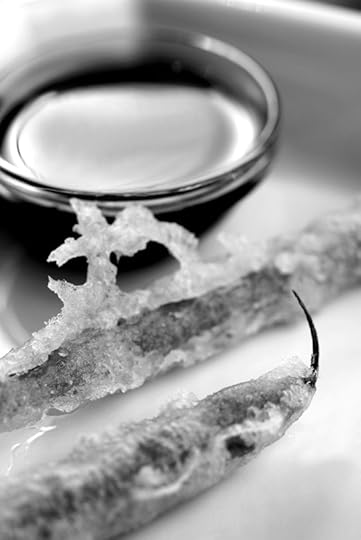
Green bean tempura/Photo by Donna Turner Ruhlman
When I was a boy, my father looked at me in the rearview mirror and asked why was I so quiet.
I said, “I have nothing to say.”
Sometimes I have something to say, and I get overheated. Right now, I have nothing to say. Unlike a daily newspaper that has to say something on schedule, has to lead with some story, I don’t. I’m a strong believer in not speaking generally (there’s too much noise as there is) but especially when I have nothing to say. (To be honest, I wouldn’t even be typing this except that I can’t stand Friday’s picture of Rose’s grenadine any longer.)
I suggest that whenever you have nothing to say, you fry something in oil, such as green beans dipped in tempura batter, which was how we got our daughter to eat green beans when she was a child.
While you are eating them, you will probably have something to say to the person you are eating them with. But if you don’t, just eat. Sometimes it’s good to just sit quietly and eat.
Quick Tempura Batter
From Ratio
Mix 2 parts flour with 1 part cornstarch, and add sparkling water till you have a light batter.
Dip vegetables in batter and deep-fry them in vegetable oil.
Serve them with a light soy sauce seasoned with vinegar.
If you liked this post, check out these other links:
My video post when I had something to say.
Take a look at Iron Chef Morimoto’s restaurants.
Humble Bean is a blog that focuses on Japanese cuisine.
© 2013 Michael Ruhlman. Photo © 2013 Donna Turner-Ruhlman. All rights reserved.
I Have Nothing To Say

Green bean tempura/photo by Donna Turner Ruhlman
When I was a boy, my father looked at me in the rear view mirror and asked why was I so quiet.
I said, “I have nothing to say.”
Sometimes I have something to say, and I get overheated. Right now, I have nothing to say. Unlike a daily newspaper that has to say something on schedule, has to lead with some story, I don’t. I’m a strong believer in not speaking generally (there’s too much noise as there is) but especially when you have nothing to say. (To be honest, I wouldn’t even be typing this except that I can’t stand Friday’s picture of Rose’s grenadine any longer.)
I suggest that whenever you have nothing to say you fry something in oil, such as green beans dipped in tempura batter, which was how we got our daughter to eat green beens when she was a child.
While you are eating them, you will probably have something to say to the person you are eating them with. But if you don’t, just eat. Sometimes it’s good to just sit quietly and eat.
Quick Tempura Batter
From Ratio
Mix 2 parts flour with 1 part corn starch, add sparkling water till you have a light batter.
Dip vegetables in batter and deep-fry them in vegetable oil.
Serve them with a light soy sauce seasoned with vinegar.
If you liked this post, check out these other links:
My video post when I “had something to say.
Take a look at Iron Chef Morimoto’s restaurants.
Humble Bean is a blog that focuses on Japanese cuisine.
© 2013 Michael Ruhlman. Photo © 2013 Donna Turner-Ruhlman. All rights reserved.
Michael Ruhlman's Blog
- Michael Ruhlman's profile
- 354 followers




